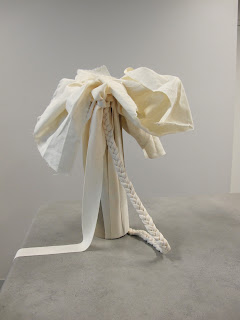A couple of weeks ago I mention 'point-light' gait analysis methods, as a way to think about the different ways we hold ourselves in walking. This is something that is explored a lot in Feldenkrais work: how can we walk more easily - taking advantage of gravity and our musculo-skeletal structure, and re-examine deeply rooted (embodied) naratives of self, self image and how we interact with the world (people) around us. To what extent does our muscular tonus (coordination of tension and relaxation) reflect core habits, and self-conception, interaction and availability to others?
Here's a link to a fascinating interactive website from BioMotion Lab, that allows you to synthesize mood and gender through a point-light animation (click on the picture to open the link):

I find it very interesting to observe pedestrians in the city from this perspective: the body-language of walking, and how we consciously or unconsciously signal our sense of power, desirability, control and mood, and then to reflect on my own musculo-skeletal organization in walking - what am I holding, how are my intentions embodied in this organisation, are these intentions aligned, or contradictory? Its easier to reflect on these very subtle (but powerful) postural differences when you can compare and contrast your own experience - this is something that is often explored in Feldenkrais 'Awareness Through Movement' lessons, at the end of each class: "how do you feel in walking now? what feels different? is this how you usually feel in walking? what in particular feels different?".
The topic of gender and walking can be particularly important for people seeking to transition from one gender to another (or something in between?), and for people who feel the need for a stronger identification with received notions of what it means to be a man or woman in our culture. Bear in mind that gait styles and their gendering can vary significantly from one culture to another, and even from one subculture to another (i.e. Sub-Saharan Africa, East-Asia, Rap/R&B culture, Bikies, Surfies, Drag Queens, Gay Twinks/Bears etc.).
Here's an interesting conversation from a transman's (female-to-male transexual)
blog by Dan4th re walking and gait analysis:
Provost et al (2008) found that women who were more fertile, or who had an "unrestricted sociosexual orientation" (more likely to engage in short-term mating) found greater masculinity more attractive in point light walkers.
…One of the first things that other transmen tried to teach me, when I was first transitioning, was how to walk like a man. I'll tell you flat out: I don't. I still catch myself with quite a bit of hip swing. Still, learning the correct walk is a huge step towards "passing" for most transfolk I've known. I am dubious but fascinated by Brooks et al's finding about walker orientation. This study used 3 men and 2 women as observers. I have to say: I probably spend more time watching men approach and women leave, but that's because I make an effort not to stare at women (when they can see me doing it).
And from a totally different perspective: a wonderful and very inspiring formal manipulation of point-light gait analysis technique by the Issey Miyake creative team
 Brainstorming in class about areas of 'Walking', I chose to follow the train of thought on POSTURE.
Brainstorming in class about areas of 'Walking', I chose to follow the train of thought on POSTURE.










































